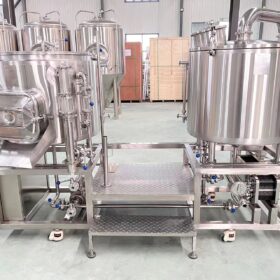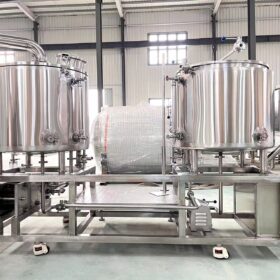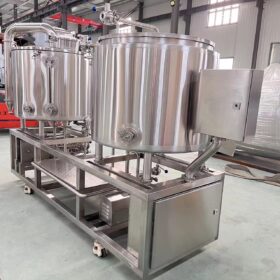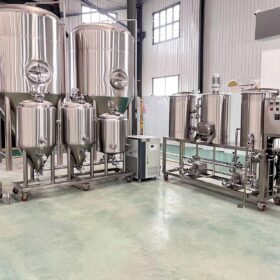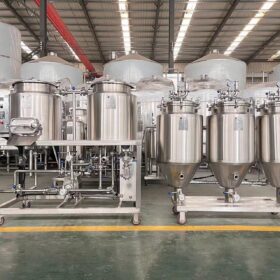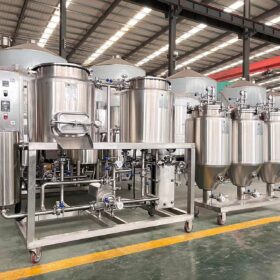Home brewing beer is a fun hobby that allows you to create customized brews with distinctive flavors right in your own kitchen. However, achieving quality home brewed beer requires having the right equipment. This guide provides an overview of the essential beer brewing gear for beginners along with additional systems for more advanced home brewers.
Overview of Beer Home Brewing Equipment
The basic home brewing equipment kit includes key components to mash malted grains, boil wort, ferment with yeast, and package the final beer. Advanced systems add functionality to control more parameters during the brewing process.
Essential Beginner Beer Brewing Gear
So, you’ve been bitten by the homebrewing bug, lured in by the siren song of crafting your own delicious suds. But before you dive headfirst into the world of malt, hops, and yeast, it’s essential to gather the right tools for the trade. Fear not, aspiring brewmaster, for this guide will equip you with the knowledge to navigate the exciting, yet potentially overwhelming, world of homebrew gear.
The Fermentation Fortress:
Your first priority is a secure vessel for your fledgling beer’s transformation. A good 5-gallon glass carboy is a classic choice, offering visibility and ease of cleaning. However, plastic buckets are budget-friendly alternatives, just ensure they’re food-grade and BPA-free. An airlock, that cute little bubbler, is crucial, allowing CO2 to escape while keeping contaminants at bay.
Brewing Up a Batch:
Next comes the wort pot, the cauldron where your magical elixir takes shape. A large stainless steel pot (at least 5 gallons) with a sturdy bottom is ideal. If you’re feeling fancy, consider a kettle with a built-in spigot for easier transferring. Remember, a heat source is necessary, whether it’s a stovetop, a propane burner, or an electric brewing system.
Taming the Temperature:
Precise temperature control is crucial for successful brewing. A good thermometer is your trusty sidekick, and for extract brewing, a simple candy thermometer will suffice. However, if you plan to graduate to all-grain brewing, investing in a digital thermometer or a temperature controller will ensure consistent results.
The Bottling Bonanza:
Once your beer has fermented, it’s time to package your bubbly bounty. Glass bottles are the traditional choice, offering a satisfying “pop” when opened. You’ll need a capper to secure the bottles and a hydrometer to measure sugar content and ensure proper carbonation. Opt for food-grade tubing and a bottling wand for easier transfer, keeping your mess to a minimum.
Sanitation is Key:
Remember, cleanliness is next to godliness in brewing. A no-brainer is a good sanitizer, readily available at homebrew stores. Invest in a spray bottle for easy application and don’t forget about starches like PBW or Five Star for cleaning. Thorough sanitation prevents unwanted bacteria from spoiling your precious brew.
Beyond the Basics:
As you gain experience, you can explore additional tools to refine your craft. A hydrometer for gravity measurements allows for calculating alcohol content and fermentation progress. For extract brewers, a hydrometer is optional, but invaluable for all-grain enthusiasts. Wort chillers, while not essential, can significantly speed up the cooling process, crucial for optimal yeast health.
Remember, brewing is a journey, not a destination. Start with the basics, brew with passion, and don’t be afraid to experiment. With the right gear and a thirst for knowledge, you’ll be well on your way to crafting beers that will impress your taste buds and quench your thirst for homebrewing adventure!
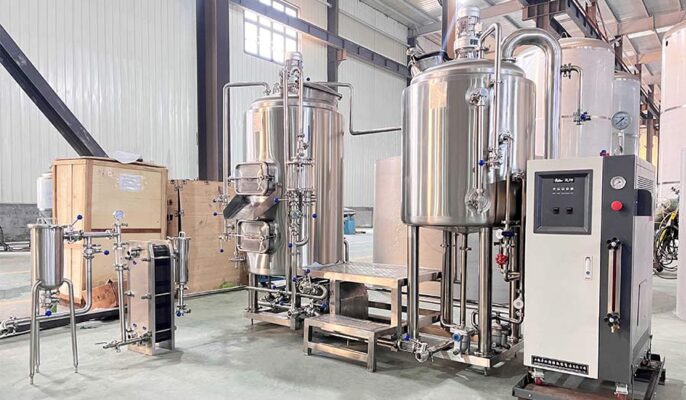
Additional Advanced Brewing Equipment
For the homebrewer who’s mastered the art of crafting delicious beer, the urge to refine, experiment, and push boundaries is ever-present. This journey leads many towards the exciting realm of advanced brewing equipment, tools designed to unlock new levels of control, precision, and flavor innovation. Let’s delve into some key pieces that can elevate your homebrew from “good” to “exceptional.”
Temperature Control: Consistency is king in brewing, and precise temperature control throughout the process is paramount. Consider investing in a fermentation chamber or chest freezer with a temperature controller. These allow you to maintain exact fermentation temperatures for specific styles, leading to cleaner flavors and increased predictability. Additionally, a glycol chiller attached to your brew kettle enables efficient wort chilling, crucial for preserving hop aromas and preventing unwanted flavors.
Mashing Magic: For all-grain brewers, a dedicated mash tun is a game-changer. Options like insulated coolers with false bottoms or electric mash systems equipped with heating elements and pumps offer superior temperature control and lautering efficiency, resulting in higher extract yields and more complex wort profiles.
Pumping Up Your Process: Moving liquids efficiently becomes crucial as batch sizes increase. Consider a centrifugal pump for transferring wort between vessels, bottling, or sparging your grains. These pumps offer smooth, controlled flow, minimizing oxidation and saving you time and effort.
Monitoring Matters: Invest in tools that provide valuable data throughout the brewing process. A digital refractometer accurately measures your wort’s gravity, helping you calculate alcohol content and monitor fermentation progress. A pH meter allows you to fine-tune mash and boil pH for optimal enzyme activity and flavor stability.
Cleanliness is Key: Sanitation is crucial for producing high-quality beer. Consider a dedicated cleaning station with a three-compartment sink and sanitizing solutions like Star San or iodophor. For larger setups, a steam wand or CIP (cleaning in place) system can streamline sanitation and ensure spotless equipment.
Kegging for Convenience: If you find yourself bottling large batches, consider making the switch to kegging. Kegs not only offer a more professional presentation but also preserve your beer’s carbonation and freshness for longer periods. Invest in kegs, a CO2 tank and regulator, and a kegerator to dispense your brews like a pro.
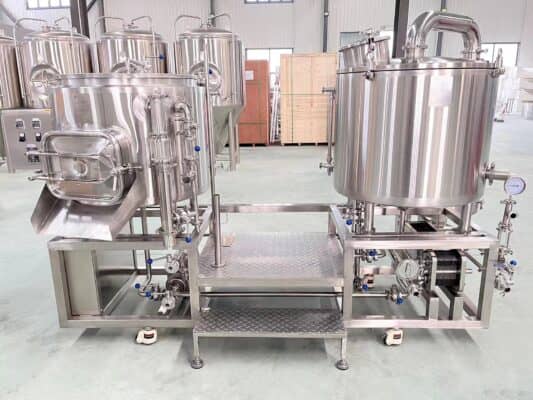
Beer Home Brewing Equipment Guide
Selecting beer brewing equipment depends on your skill level, batch size, and budget. This guide covers beginner gear to advanced systems.
Table 1: Overview of Home Brewing Gear Types
| Equipment Type | Description |
|---|---|
| Brew Kettle | Boils malt sugar water to make wort |
| Fermenter | Ferments wort with yeast to make beer |
| Temperature Control | Maintains fermentation temperature |
| Testing Equipment | Measures specific gravity, pH, etc |
| Transfer Equipment | Siphons liquids between vessels |
| Sanitation | Cleans and sterilizes equipment |
| Carbonation | Creates carbonation; bottling, kegging |
| Ingredients | Malted barley, hops, yeast |
| Storage | Stores finished beer; bottles, kegs |
Beer Home Brewing Equipment Based on Batch Size
The equipment size should match your target batch volume of home brewed beer.
Table 2: Beer Home Brewing Equipment Batch Sizes
| Batch Size | Kettle Size | Fermenter Size |
|---|---|---|
| 1 gallon | 3 gallon kettle | 1 gallon carboy |
| 5 gallons | 7 gallon+ kettle | 6 gallon carboy |
| 10 gallons | 15+ gallon kettle | 6.5-7 gallon bucket |
For larger batch sizes, upgrade to a 20+ gallon brew kettle and conical fermenters over 13 gallons.
Design and Customization
The usual stainless steel brew kettles and plastic fermenters come in standard shapes and sizes. For more advanced functionality or visual appeal, custom systems allow personalization.
Table 3: Beer Brewing Equipment Design and Customization
| Parameter | Standard Equipment | Custom Systems |
|---|---|---|
| Shape/Dimensions | Fixed kettle diameters; carboys | Any kettle size or shape |
| Material | Stainless steel, plastic | Copper, wood, stone, glass |
| Visual Appeal | Basic stainless or plastic vessels | Custom graphics, etching, colors |
| Functionality | Typical homebrew features | Advanced automation, valves, sensors |
| Cost | Affordable, mass produced | Expensive, custom fabrication |
Suppliers and Price Ranges
Home brewing equipment is available from homebrew shops to online retailers in starter kits or as individual pieces.
Table 4: Beer Home Brewing Gear Suppliers and Prices
| Supplier Type | Vendor Examples | Price Range |
|---|---|---|
| Local Homebrew Shops | MoreBeer, Northern Brewer | $50 – $1500 |
| Online Retailers | Amazon, Webstaurant Store, Alibaba | $30 – $3000+ |
| Custom Fabricators | JV Northwest, Essential Brewing | $500 – $5000+ |
Installation, Operation and Maintenance
Proper use and care of brewing equipment improves safety, efficiency and beer quality.
Table 5: Beer Brewing System Set Up and Usage
| Activity | Guidelines |
|---|---|
| Installation | Level gear on sturdy stands, arrange flow from top to bottom |
| Safety | Ensure stable mounts to prevent tipping, install evaporative hoods |
| Operation | Follow manufacturer instructions for each component |
| Maintenance | Disassemble and clean thoroughly after each use; replace gaskets, poppets |
| Efficiency | Insulate vessels, recirculate wort and reuse heat |
Choosing Beer Brewing Equipment Suppliers
Select vendors based on available budget yet ensure adequate quality and functionality
Table 6: Assessing Beer Brewing Gear Suppliers
| Criteria | Considerations |
|---|---|
| Budget | Lower cost vs premium equipment |
| Quality | Material thickness; welds, valves, seals |
| Customer Support | Instructions; service policies |
| Item Reviews | Durability, defects, recommendations |
| Purpose | Match gear to personal skill level |
Comparing Home Brewing Systems
Various configurations of beer making equipment each have pros and cons.
Table 7: Beer Home Brew Equipment Comparison
| System | Advantages | Disadvantages |
|---|---|---|
| Basic Stovetop Kits | Lower cost, easy set up | Temperature control difficult; smaller batches |
| Electric Systems | Precise temp control; automation | More expensive; equipment required |
| Advanced RIMS/HERMS | High efficiency; all-grain flexibility | Complex; space requirements |
Electric brewing systems provide the best functionality for the cost but require an electrical setup. Fully automated RIMS or HERMS configurations can achieve commercial beer consistency through advanced monitoring and control of the mashing and boiling process. However this gear requires both an electrical infrastructure as well as pumps, valves and a convoluted plumbing configuration driving up startup costs. Stovetop kits offer an affordable introduction but scaling up is limited.
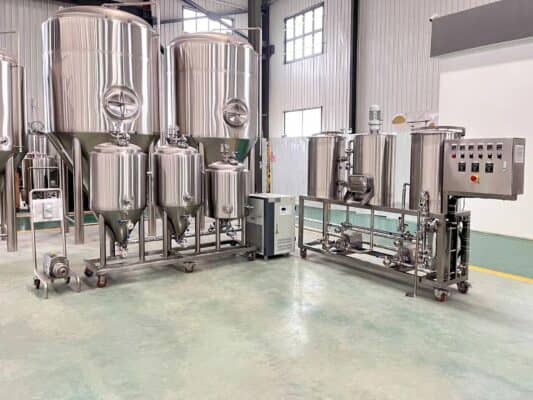
FAQ
What is the most beginner friendly home brewing equipment?
For first time home brewers, start with an inexpensive stovetop brewing kit. This allows you to learn the basics without a large investment. Upgrade to electric systems with more precise control as you advance.
What size beer making equipment do I need?
Select gear that aligns with your target batch size – bigger batches may save time but require larger, more expensive components. Start with 1 gallon batches, then potentially scale up to 5 gallons once comfortable with the process.
Is plastic or stainless steel better for home brewing?
Both stainless steel and food-grade plastic work well. Stainless holds up longer but plastic fermenters allow checking batch progress. Use stainless for heating elements, plastic for cold side transfer and fermentation.
Can I build my own home brewery equipment?
Building your own gear is possible but can be challenging to construct vessels that properly seal, especially main brew kettles. Unless you have metal fabrication skills, start with retail kits then potentially customize components later on.
Conclusions
Configuring a beer home brewing system involves selecting equipment that achieves your target batch size and functionality based on available space and budget. Start with basic kits to hone techniques before expanding layouts and upgrading parts. Focus on critical components first – a brew kettle and fermenter vessel with temperature control for proper yeast activity. Prioritize spending on gear that enables sanitation and temperature regulation. With the right home brewery equipment – and practice in process – soon you’ll be crafting interesting new beer recipes to perfection from the comfort of your own home.





